1. Project Introduction
Morph is an innovative project dedicated to applying blockchain technology to daily life. Its mission is to make blockchain technology decentralized, fair, and accessible to all. The architecture of Morph combines the advantages of Optimistic Rollup and zkRollup, and utilizes decentralized sequencers and modular design to reduce development and operational costs, and enhance market competitiveness.
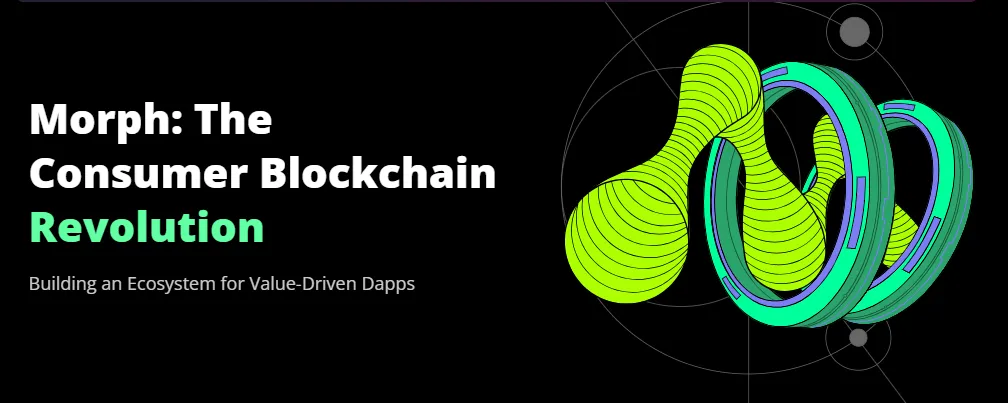
Morph's technological logic and ecological positioning are unique in the current crowded L2 track, mainly addressing the liquidity fragmentation and user security issues of existing L2 projects. Moreover, Morph's consumer-grade L2 positioning has attracted a large number of Web2 users to enter the Web3 world by providing rich application scenarios and a low threshold experience.
Azim Khan, co-founder and COO of Morph, emphasized that Morph aims to solve a key issue in the current blockchain field, which is that existing products mainly target industry professionals rather than ordinary users. In order for the blockchain industry to mature, products must be simplified to make them easy for ordinary users to use. Therefore, while Morph focuses on technology, it is also committed to reducing the difficulty for users to get started, thus attracting more ordinary users.
2. Core Mechanism
2.1 Decentralized Sequencer Network
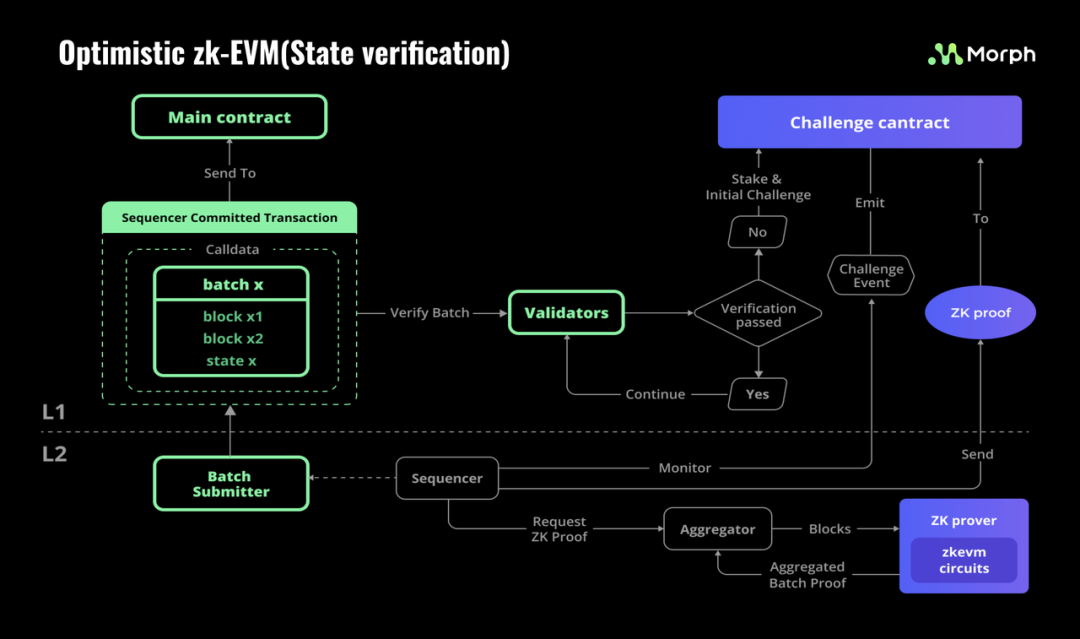
2.1.1 Background and Motivation
In traditional Layer 2 (L2) solutions, sequencers are usually centralized. This centralized sequencer, while capable of providing fast transaction confirmation speeds, has the following problems:
- Single point of failure: Once a centralized node fails, the entire network may experience long periods of downtime.
- Unfair transaction ordering: A centralized sequencer may prioritize transaction ordering based on individual profit maximization, arbitrarily adjusting transaction ordering to obtain more Miner Extractable Value (MEV), and may even censor or reject certain user transactions.
Morph solves the above problems through a decentralized sequencer network, ensuring the security, stability, and fairness of the network. Its design principles include efficiency, low cost, scalability, and ease of maintenance.
2.1.2 Key Features
- Multi-node participation: Morph's decentralized sequencer network allows multiple nodes to participate in transaction packaging and ordering, rather than being controlled by a single node. This multi-node participation mechanism increases the network's resilience, ensuring that even if one node fails, other nodes can continue to process transactions.
- Elimination of single point of failure: With the sorting task shared among multiple nodes, the risk of a single point of failure is significantly reduced, ensuring the network's continuous operation.
- Fair ordering: The decentralized sorting mechanism ensures that transactions are ordered based on fair principles, avoiding individual nodes' manipulation and enhancing transaction transparency and fairness.
2.1.3 Operation Mechanism
In Morph's decentralized sequencer network, multiple sequencer nodes work together to process transactions. Its specific operation mechanism is as follows:
- Selection of sequencer nodes: Sequencer nodes are selected through a competitive mechanism, ensuring that each node has the opportunity to participate in transaction ordering. This mechanism not only increases the network's decentralization, but also incentivizes more nodes to participate.
- Transaction packaging and ordering: Each sequencer node is responsible for packaging and ordering received transactions. Sequencer nodes follow established fair rules when packaging and ordering transactions, ensuring that the order of transactions is not manipulated by individual nodes.
- Sequencer rotation submission: Sequencer nodes take turns submitting packaged transactions to the Ethereum mainnet. This rotation mechanism avoids the excessive burden of a single node and ensures the continuous submission of transactions.
2.1.4 Incentive Mechanism
To incentivize more nodes to participate in sorting, Morph has designed a set of incentive mechanisms:
- Sequencer profit distribution: After collecting user transaction fees, sequencers redistribute profits to on-chain projects and DApp developers according to a predetermined allocation mechanism. This distribution mechanism not only incentivizes more nodes to participate in sorting, but also encourages more projects and developers to build and operate DApps on the Morph platform.
- Fair competition: Through fair profit distribution and competition mechanisms, it ensures that each sequencer node and project can receive corresponding rewards based on their contributions, stimulating community members' enthusiasm.
2.1.5 Security and Efficiency
The decentralized sequencer network not only enhances the security of the Morph network, but also improves transaction processing efficiency:
- Security: The decentralized sequencer eliminates the risks of single point of failure and unfair transaction ordering brought by centralization, ensuring the overall security of the network.
- Efficient processing: The collaborative work of multiple nodes improves the efficiency of transaction processing, ensuring that transactions can be confirmed and processed quickly.
2.1.6 Impact on the Ecosystem
Morph's decentralized sequencer network has brought significant positive impacts to its ecosystem:
- Promoting the development of decentralized applications (DApps): Through fair sorting and incentive mechanisms, it has attracted more developers to build DApps on the Morph platform, promoting the prosperity of the ecosystem.
- Enhancing user trust: The decentralized sequencer network has increased transaction transparency and fairness, enhancing users' trust in the Morph network.
Morph's decentralized sequencer network, through multi-node participation, fair sorting, incentive mechanisms, and efficient processing, addresses the single point of failure and unfair transaction ordering issues of traditional centralized sequencers, improving the security and efficiency of the network. At the same time, this decentralized sequencer network has laid a solid foundation for the prosperity of the Morph ecosystem, driving innovation in more decentralized applications and active user participation.
2.2 Responsive Validity Proof (RVP)
Morph's RVP combines the advantages of Optimistic Rollup and zkRollup, using zkProof to verify the correctness of the state while retaining the efficient transaction processing capability of Optimistic Rollup. This design allows RVP to find the optimal balance between security and efficiency.
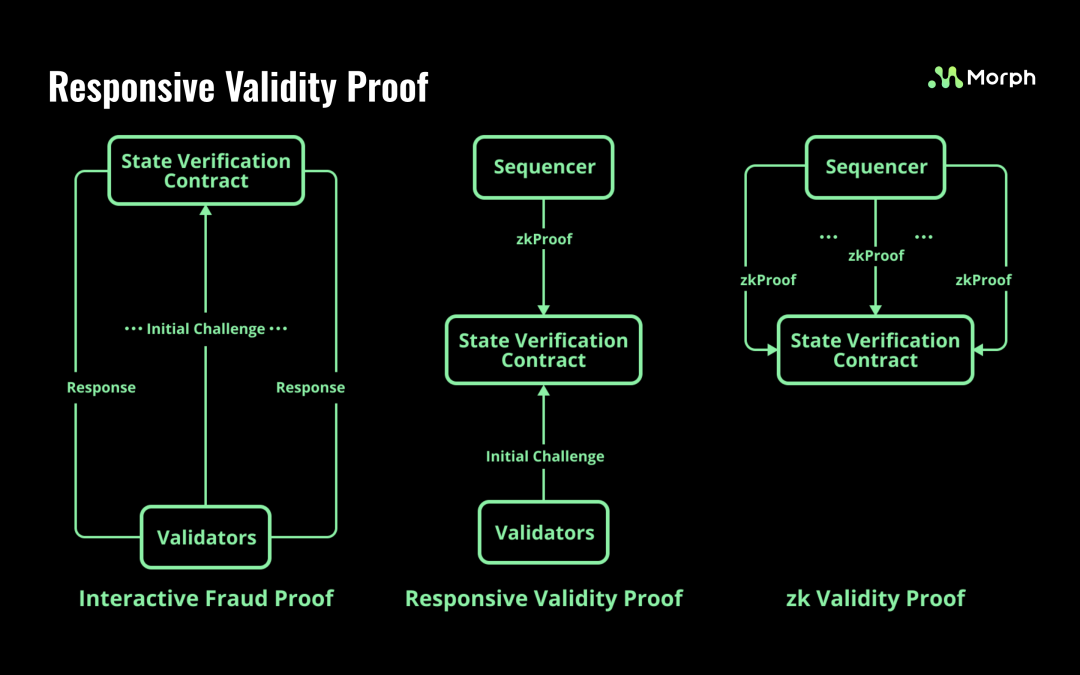
2.2.1 Key Features:
- Hybrid verification mechanism: RVP uses a hybrid verification mechanism of Optimistic Rollup and zkRollup. By default, the system processes transactions efficiently and uses zkProof to verify transaction correctness when challenged.
- Shortened challenge period: Through zkProof verification, RVP shortens the traditional Optimistic Rollup challenge period from 7 days to 1-2 days, improving transaction confirmation speed.
- Efficient state verification: During transactions, sequencers generate zkProof to verify the correctness of the state, which not only enhances verification security but also reduces computational overhead.
2.2.2 Operation Mechanism
In Morph's RVP system, the transaction verification process is as follows:
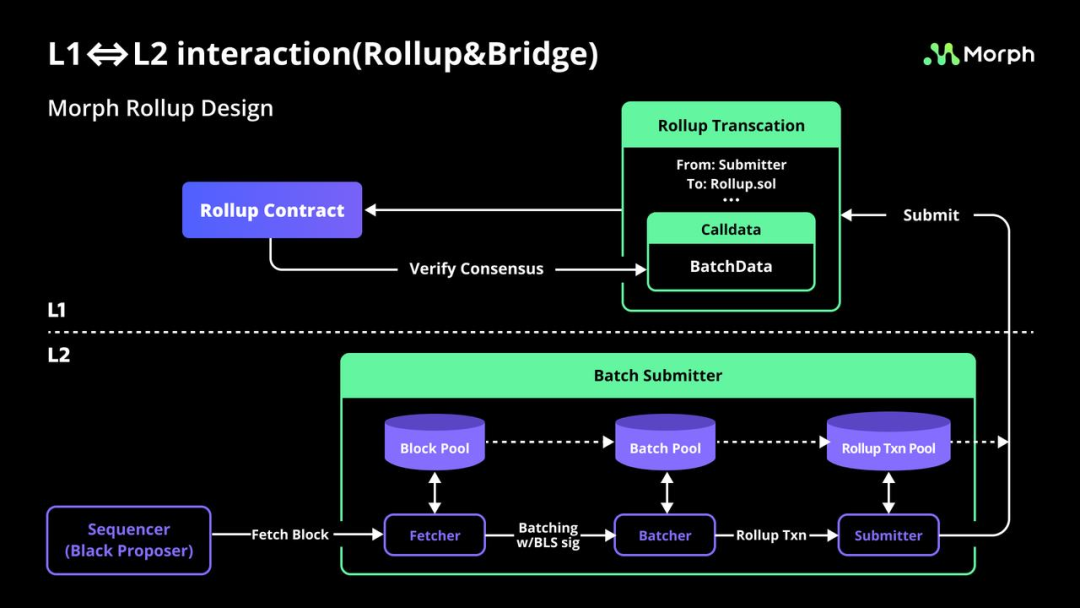
- Transaction Processing: After users submit transactions, the sequencer processes transactions quickly in the manner of Optimistic Rollup and packages them into blocks for submission to Layer 1.
- State Challenge: During the state challenge period, any node can challenge the submitted state. If challenged, the sequencer needs to generate zkProof to verify the correctness of the state.
- zkProof Verification: The sequencer generates zkProof and submits it to Layer 1 for verification. If the verification passes, the transaction state is confirmed; if the verification fails, the transaction state is rolled back, and the challenger receives a reward.
2.2.3 Security and Efficiency
The design of RVP ensures efficient transaction processing and strong security:
- Efficient Transaction Processing: By default, transactions are processed in the manner of Optimistic Rollup, ensuring efficient transaction speed.
- Strong Security: By verifying transaction correctness through zkProof, RVP provides strong security when challenged, preventing malicious transactions and state fraud.
- Reduced Computational Overhead: The hybrid verification mechanism of RVP reduces the frequency of zkProof computation, generating zkProof only when challenged, thus reducing computational overhead.
2.2.4 Impact on the Ecosystem
The introduction of RVP has had a significant positive impact on the Morph ecosystem:
- Enhanced User Trust: Through strong security and efficient transaction processing, RVP has enhanced user trust in the Morph platform.
- Promotion of DApp Development: The efficient and secure transaction verification mechanism has attracted more developers to build decentralized applications (DApps) on the Morph platform, promoting ecosystem prosperity.
- Lowering Development Barriers: The hybrid verification mechanism of RVP simplifies the trade-off between security and efficiency for developers, making it easier to build and deploy applications on the Morph platform.
Morph's Responsive Validity Proof (RVP) finds the optimal balance between efficient transaction processing and strong security by combining the advantages of Optimistic Rollup and zkRollup. The design of RVP not only improves transaction confirmation speed but also ensures transaction security and reduces computational overhead. Through RVP, the Morph platform provides users with an efficient and secure transaction experience and creates an ideal environment for developers, promoting the prosperity of the ecosystem.
2.3 Modular Architecture
Morph's modular architecture consists of three main modules: Consensus and Execution Module, Settlement Module, and Data Availability Module. This design not only improves the system's flexibility and scalability but also reduces the complexity of development and operation.

2.3.1 Key Features
- Separation of Consensus and Execution: The separation of consensus and execution functions, similar to the design of Ethereum 2.0, avoids the packaging of invalid transactions and improves system efficiency.
- Modular Collaboration: Each module runs independently and collaborates to ensure the efficient operation and flexible expansion of the system.
- High Compatibility: Modular design ensures high compatibility with Ethereum and other blockchain systems, facilitating migration and integration for developers and projects.
Morph's modular architecture consists of the following three main modules:
2.3.2 Consensus and Execution Module (Sequencer Network)
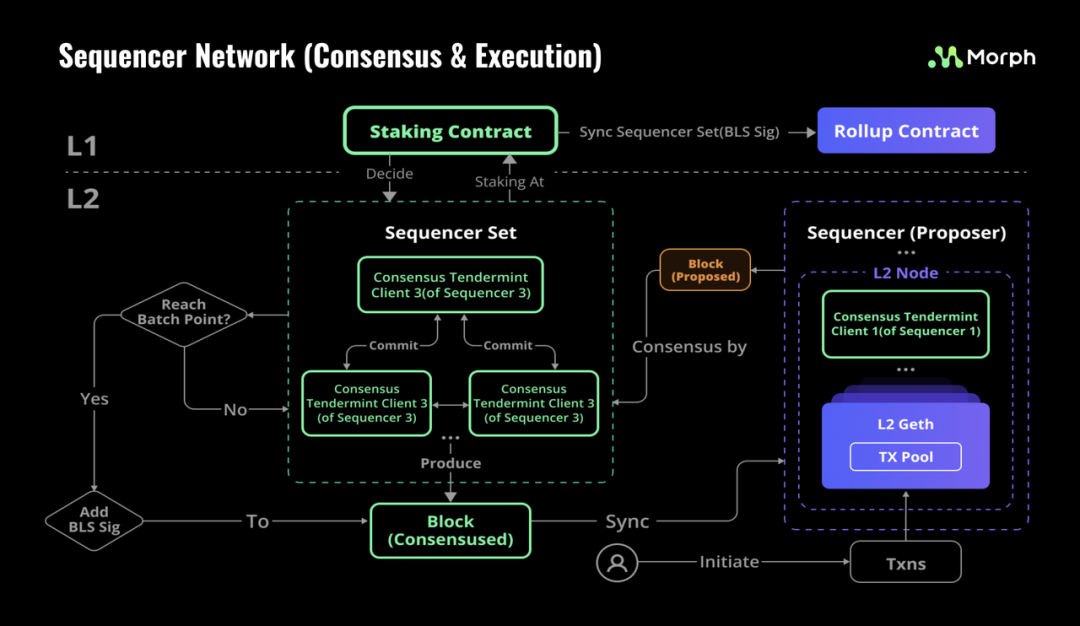
- Responsibility: Responsible for transaction sorting and execution to ensure sequential transactions.
- Decentralized Sequencer: Utilizes a decentralized sequencer network where multiple nodes participate in transaction packaging and sorting, enhancing system security and fairness.
- Separation Design: Separation of consensus and execution functions to prevent invalid transactions from entering blocks, reducing user fee losses.
2.3.3 Settlement Module (Optimistic zkEVM)
- Responsibility: Responsible for transaction settlement and state verification.
- Optimistic zkRollup: Combines the advantages of Optimistic Rollup and zkRollup to provide efficient and secure state verification.
- RVP Verification: When challenged, verifies transaction correctness through zkProof to ensure transaction security.
2.3.4 Data Availability Module (Rollup)
- Responsibility: Ensures the availability and storage of transaction data.
- Data Compression: Utilizes zkProof to compress block content, effectively managing the cost of L1 data availability.
- Multi-node Submission: Multiple sequencer nodes take turns submitting batches to avoid single point of failure and ensure the liveness of data submission.
2.3.5 Advantages
Morph's modular architecture has significant advantages in flexibility, scalability, and compatibility:
- Flexibility: Each module runs independently, allowing developers to choose and adjust modules according to their needs to adapt to different application scenarios.
- Scalability: Modular design facilitates system expansion and upgrades, enabling quick adaptation to new technologies and standards.
- Low-Cost Operation and Maintenance: Modular architecture reduces the complexity of development and operation, simplifying system management and maintenance.
- High Compatibility: High compatibility with Ethereum and other blockchain systems facilitates migration and integration for developers and projects.
2.3.6 Impact on the Ecosystem
The modular architecture has a significant impact on the construction and development of the Morph ecosystem:
- Promotion of DApp Development: High flexibility and low-cost operation and maintenance attract more developers to build DApps on the Morph platform, promoting ecosystem prosperity.
- Enhanced User Experience: Efficient transaction processing and secure state verification enhance user transaction experience and trust in the Morph platform.
- Simplified Development Process: Modular design simplifies the development process for developers, making it easier to build and deploy applications on the Morph platform.
Morph's modular architecture, through the separation of consensus and execution, settlement, and data availability modules, provides a flexible, scalable, and easy-to-maintain blockchain infrastructure. Through this modular design, Morph offers an efficient, secure, and low-cost blockchain solution, enhancing system performance and security, simplifying the development process for developers, and promoting the prosperity of the ecosystem.
3. Ecosystem
Morph's ecosystem construction goal is to attract developers and users to join its platform through providing powerful technical infrastructure and diverse incentive mechanisms, thereby promoting the widespread application of blockchain technology and the prosperity of the ecosystem.
3.1 Ecosystem Construction Strategy
Morph's ecosystem construction strategy includes the following aspects:
- Collaboration with BitGet
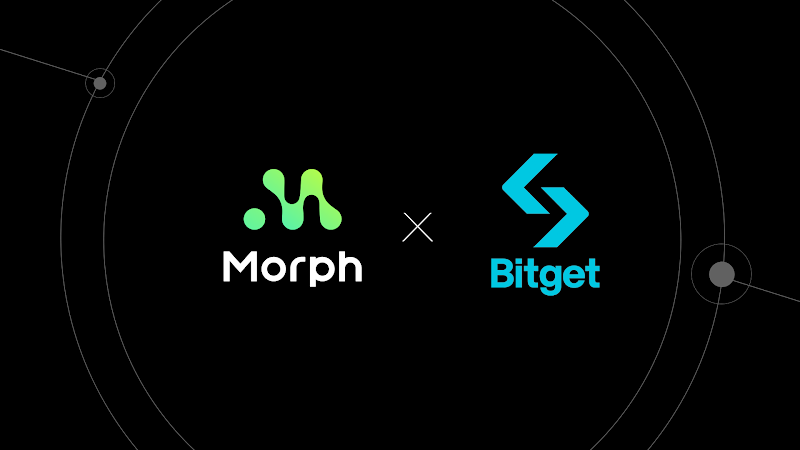
Morph has partnered with the globally renowned cryptocurrency exchange BitGet to quickly guide initial liquidity and user trading through its vast user base and exchange resources, creating a strong developer ecosystem.
- BitGet User Base: BitGet has tens of millions of users, and by leveraging these user resources, Morph can quickly guide initial liquidity and drive user trading.
- BitGet Wallet: The BitGet wallet also provides users with convenient trading and asset management tools, further promoting user participation and trading activities.
- Ecosystem Activities and Plans
Morph has continuously launched a series of ecosystem activities and plans to attract developers and projects to build and operate decentralized applications (DApps) on its platform.
SparkLoom Builder Program: A four-month plan that includes online hackathons and an incubator program, offering a total of $20,000 in hackathon prize pool and inviting winners to join the incubator program, with the potential to receive up to $100,000 in funding and 30% of the total Morph airdrop.
HackSummit Hackathon: A hackathon competition jointly organized with Berachain, Solana, The Graph, and others, providing various workshops and lectures on Web3 technology applications and setting up rewards to drive the development and application of Web3 technology.
Offline Meetups and MiniHackerHouse: Offline events jointly organized with OpenBuild, Chainlink, and others to help developers interested in blockchain enter the Ethereum ecosystem for development.
- Funding and Technical Support
Morph provides diverse funding and technical support to help developers and projects innovate and grow on its platform.
Funding Support: Through the SparkLoom incubator program and other incentive programs, Morph provides grants of up to $100,000 and 30% of the initial Morph airdrop, helping projects achieve rapid development from 0 to 1.
Technical Guidance: Provides mentorship guidance from well-known institutions such as Dragonfly, Pantera, LayerZero, and others to help developers solve technical challenges and accelerate project development and implementation.
3.2 Incentive Mechanism
Morph's incentive mechanism is designed to incentivize developers and users to participate in the construction and development of the ecosystem in a fair and transparent manner.
- Decentralized Sequencer Incentives
Morph's decentralized sequencer network not only enhances system security and fairness but also redistributes sequencer profits to on-chain projects and DApp developers, incentivizing them to innovate and develop on the platform.
Profit Distribution: After collecting user transaction fees, the sequencer redistributes profits to on-chain projects and DApp developers according to a predetermined allocation mechanism, ensuring that each participant receives corresponding rewards based on their contributions.
- Developer Incentives
Through diverse incentive programs, Morph has attracted a large number of developers to build and operate DApps on its platform.
SparkLoom Builder Program: Offers generous prize pools and incubator funding to attract outstanding developers to participate in ecosystem construction.
Technical Support and Guidance: Provides professional technical guidance to help developers solve technical challenges and improve development efficiency.
- User Incentives
Morph uses diverse user incentive programs to increase user participation and activity, promoting the healthy development of the ecosystem.
Usage Rewards: Users can receive transparent and fair rewards for using the protocol, holding positions, and engaging in lending operations.
Community Participation: Through the profit distribution mechanism of the decentralized sequencer, users can also share in the network's profits, enhancing community cohesion and participation.
3.3 Impact on the Ecosystem
Morph's ecosystem construction and incentive mechanism have far-reaching effects on the development of its platform:
Promotion of Decentralized Application (DApp) Prosperity: The powerful technical infrastructure and diverse incentive mechanisms have attracted a large number of developers and projects to build and operate DApps on the Morph platform, promoting the prosperity of the ecosystem.
Enhanced User Experience: An efficient, secure, and fair trading environment has increased user participation and satisfaction, enhancing user trust in the Morph platform.
Enhanced Community Cohesion: The fair and transparent incentive mechanism has strengthened community cohesion, attracting more users and developers to join the ecosystem and collectively promote platform development.
Morph's ecosystem construction and incentive mechanism, through collaboration with BitGet, the launch of diverse ecosystem activities and plans, provision of funding and technical support, and fair and transparent incentive mechanisms, have attracted a large number of developers and users to participate in its platform. Through these measures, Morph has not only promoted the widespread application of blockchain technology but also fostered the prosperity of the ecosystem, laying a solid foundation for future innovation and growth.
4. User Guide
4.1 Steps
Step 1: Preparation
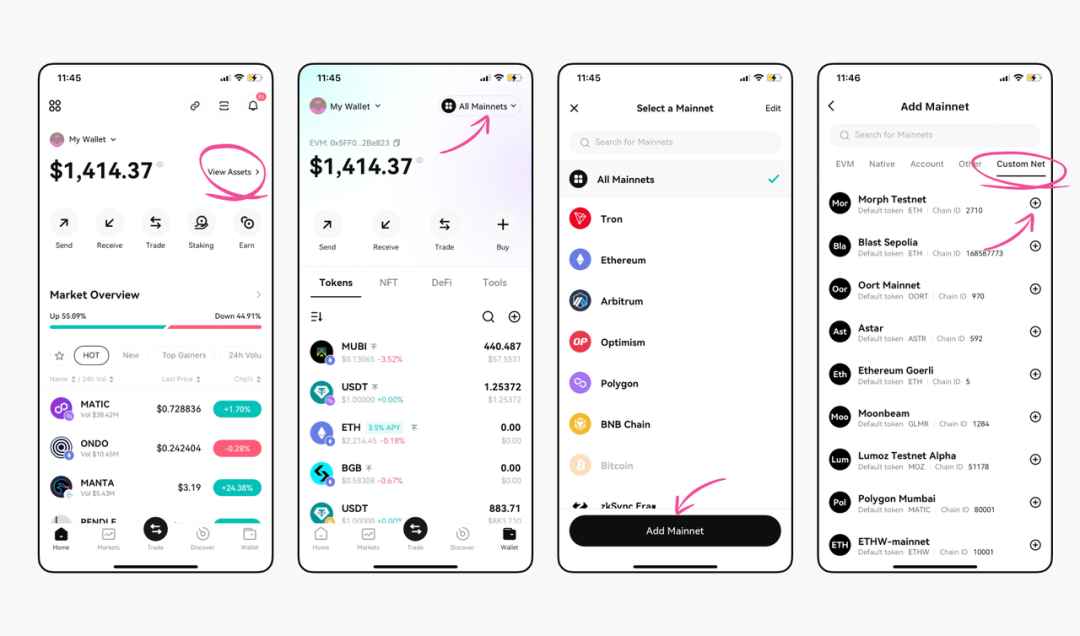
Install Metamask:
Ensure that the Metamask plugin is installed in your browser.
Obtain Sepolia ETH:
Visit the Sepolia Faucet to receive Sepolia ETH.
Add Morph Testnet Network:
Visit Chainlist.
Connect your Metamask wallet and search for the Morph Testnet.
Add the Morph Testnet to Metamask.
4.2
Step 2: Bridge ETH to Morph Testnet
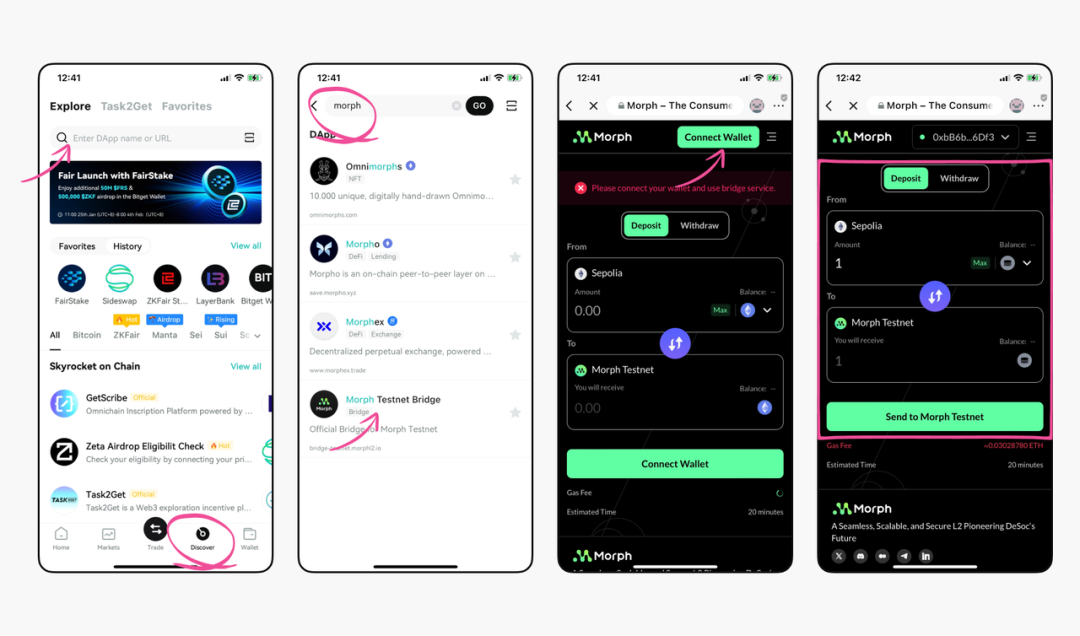
Visit Bridge Page:
Go to the Morph Testnet Bridge.
Connect your Metamask wallet or Bitget wallet.
Bridge ETH:
On the Bridge page, select the amount of ETH to bridge (it is recommended to split 0.5 ETH into multiple small transactions).
Confirm the transaction and pay the network fee, then wait for the transaction to complete (approximately 20 minutes).
Bridge back to Sepolia:
After completing the bridge, you can choose to bridge ETH from the Morph Testnet back to Sepolia.
This step may take longer (20 minutes to 7 days). After the transaction is completed, remember to claim the ETH on the Sepolia network.
4.3
Step 3: Participate in the Galaxy Activity
Participate in the Activity:
Visit the Galaxy activity page.
Complete the following tasks: follow, join Discord, join Telegram, read documents, bridge ETH, like and share, etc.
Claim NFT:
After completing the tasks, use the Bitget wallet to claim the NFT, which may be used for future airdrop snapshots.
Team/Financing Situation
Morph's team is composed of experienced professionals in the blockchain and finance industries, with backgrounds in marketing, business development, project management, and strategic planning. The team is dedicated to driving the widespread application of blockchain technology in finance, gaming, social media, and entertainment through innovative Layer 2 solutions.
Co-founder and CEO Cecilia Hsueh, formerly CEO of Phemex, holds a Bachelor's degree in Marketing from East China Normal University and has extensive leadership experience in finance and blockchain.
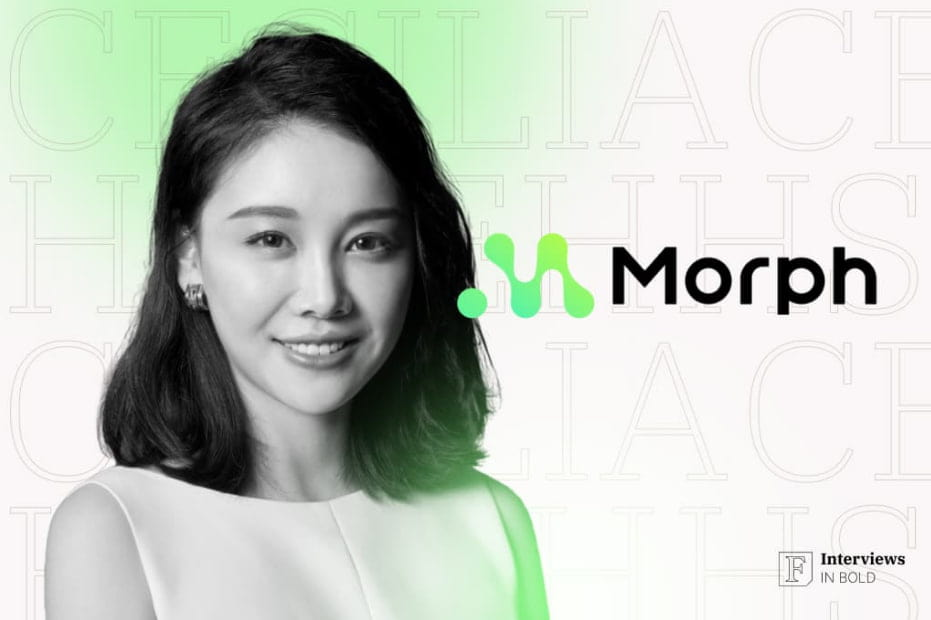
Co-founder and COO Azeem Khan, previously Head of Impact at Gitcoin and a partner at Foresight Ventures, is also a mentor at ConsenSys Accelerator, bringing deep project management and strategic planning experience in the blockchain ecosystem.

In March 20, 2024, Morph successfully raised $20 million in seed funding. The seed round was led by Dragonfly, Pantera Capital, Foresight Ventures, MH Ventures, and The Spartan Group.
These funds will be used for further development and promotion of its innovative Layer 2 solution. Through collaboration with renowned investment institutions and individual investors, Morph plans to accelerate the growth of its platform and drive the widespread application of blockchain technology in finance, gaming, social media, and entertainment.
Additionally, on December 11, 2023, Morphism announced a multi-million dollar investment from the cryptocurrency exchange Bitget, with specific terms undisclosed. This investment will further drive its technological development, particularly in the cost-effectiveness, security, and scalability of blockchain transactions.
6. Project Evaluation
6.1 Track Analysis
The Morph project belongs to the field of Layer 2 extension solutions for blockchain technology. Specifically, it is an EVM-compatible Layer 2 network that combines Optimistic Rollup and zkRollup technologies to provide efficient, secure, and scalable blockchain infrastructure. This makes Morph particularly suitable for decentralized applications (DApps) that require high throughput and low latency, such as finance, gaming, social media, and entertainment applications.
Similar projects to Morph mainly include other Layer 2 extension solutions that are also dedicated to improving the scalability and efficiency of blockchain. Some similar projects include:
Polygon (MATIC):
Polygon is a Layer 2 scaling platform that offers various scaling solutions, including Plasma Chains, zkRollups, and Optimistic Rollups.
Key Features: Combination of multiple scaling technologies, Ethereum compatibility, and a wide developer ecosystem.
Arbitrum:
Arbitrum is a Layer 2 solution based on Optimistic Rollup technology, aiming to provide fast and low-cost Ethereum transactions.
Key Features: Efficient transaction processing capacity, strong security, and compatibility.
Optimism:
Optimism is a Layer 2 scaling solution using Optimistic Rollup technology, focusing on improving Ethereum's scalability.
Key Features: Efficient transaction processing, strong developer tool support, and a wide ecosystem of partners.
6.2 Project Advantages
Technological Innovation
Decentralized Sequencer Network: Enhances network security and fairness, avoiding single point of failure and transaction ordering issues caused by centralized sequencers.
Responsive Validity Proofs (RVP): Combines the advantages of Optimistic Rollup and zkRollup to provide efficient and secure transaction verification, reducing challenge periods and computational expenses.
Modular Architecture: Provides flexible, scalable, and easy-to-maintain blockchain infrastructure, allowing developers and projects to adjust and expand according to their needs.
Strong Investment Support
Supported by well-known investment institutions such as Dragonfly, Pantera Capital, and Foresight Ventures, with a total funding amount of $20 million, in addition to a multi-million dollar investment from Bitget. These funds will help drive Morph's technological development and market promotion.
Wide Range of Application Scenarios
Suitable for various application scenarios such as finance, gaming, social media, and entertainment, meeting the demand for high throughput and low latency through efficient and secure transaction processing capacity.
Ecosystem Construction
Attracts developers and projects to build and operate DApps on its platform through the SparkLoom Builder Program and various hackathon activities, promoting the prosperity of the ecosystem.
Provides diverse incentive programs to enhance community cohesion and participation.
6.3 Project Weaknesses
Intense Competition
The market for Layer 2 extension solutions is highly competitive, with projects such as Polygon, Arbitrum, Optimism, zkSync, and StarkNet already occupying a certain market share. Morph needs continuous innovation in technology and market promotion to stand out in the competition.
Early Stage of the Project
Morph is currently in the testnet stage, and its technological and market promotion are not fully mature. The actual performance and feasibility of the project still need to be verified through mainnet launch and large-scale application.
Despite receiving substantial funding support, the challenge lies in effectively utilizing these funds to rapidly achieve technological development and market expansion.
User Base and Community Building
Compared to some competitors with established user bases and communities, Morph needs more time and resources to expand its user base and community scale.
While attracting developers and users through various incentive programs, the effectiveness of these programs remains to be observed.
Dependence on Ecosystem Partners
The development of Morph largely depends on collaboration with ecosystem partners such as Bitget. While these partners can provide funding and resource support, it also means that the project's development is subject to the partners' strategies and resource allocation.
6.4 Future Potential
According to its roadmap, the Morph project demonstrates a clear development plan, from the testnet to gradual updates to the mainnet.
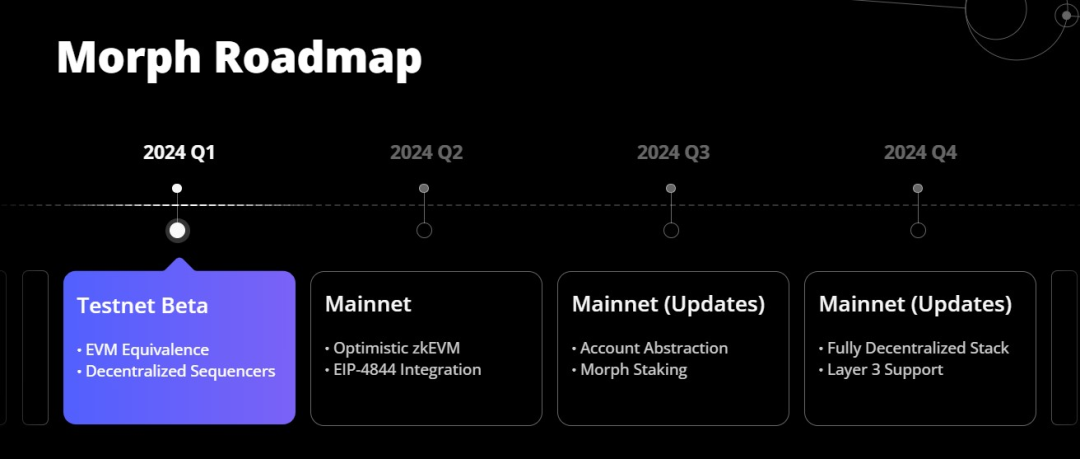
2024 Q1: Testnet Beta
EVM Equivalence:
By achieving EVM equivalence, Morph ensures compatibility with the Ethereum Virtual Machine (EVM). This means that developers can easily migrate existing Ethereum applications to the Morph network, reducing migration costs and complexity.
Decentralized Sequencer:
Implementing a decentralized sequencer helps enhance network security and fairness, avoiding single point of failure and transaction ordering issues. This will enhance user trust in the network and promote more user and developer participation.
2024 Q2: Mainnet
Optimistic zkEVM:
Combining Optimistic and zkEVM technologies to provide more efficient and secure transaction processing. This innovation will greatly enhance network performance, meeting the demand for high throughput and low latency.
EIP-4844 Integration:
By integrating EIP-4844, Morph will further optimize data storage and processing, improving network scalability and cost-effectiveness.
- 2024 Q3: Mainnet Update
Account Abstraction:
Account abstraction will simplify the user experience, enhance the flexibility and operability of smart contracts. This will help attract more developers to build complex decentralized applications (DApps).
Morph Staking:
Introducing a staking mechanism, users can earn rewards through staking, which will enhance network security and community engagement.
- 2024 Q4: Mainnet Update
Fully Decentralized Stack:
Implementing a fully decentralized technical stack to ensure a high degree of decentralization and autonomy, enhancing resistance to censorship.
Layer 3 Support:
Introducing Layer 3 support to provide infrastructure for further expansion and complex applications. This will attract more innovative projects to join the Morph ecosystem.
7. Conclusion
In conclusion, the Morph project provides an efficient, secure, and scalable Layer 2 solution through innovative technical architecture, combining Optimistic and zkEVM technologies. Its strong investment support and wide range of application scenarios give it significant advantages. With staking mechanism and account abstraction, Morph provides a high-quality user experience and development environment. With the gradual launch and updates of the mainnet, Morph is expected to stand out in the blockchain Layer 2 track and drive the widespread application of blockchain technology.
免责声明:本文章仅代表作者个人观点,不代表本平台的立场和观点。本文章仅供信息分享,不构成对任何人的任何投资建议。用户与作者之间的任何争议,与本平台无关。如网页中刊载的文章或图片涉及侵权,请提供相关的权利证明和身份证明发送邮件到support@aicoin.com,本平台相关工作人员将会进行核查。




